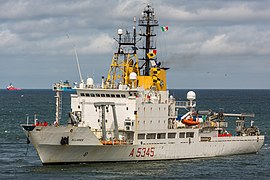Engineering:Italian ship Alliance (A 5345)
 Alliance A5345, La Spezia
| |
| History | |
|---|---|
| Name: | Alliance |
| Owner: | NATO |
| Builder: | Fincantieri – Cantiere Navale del Muggiano (La Spezia) |
| Laid down: | 18 June 1984 |
| Launched: | 9 July 1986 |
| Commissioned: |
|
| Homeport: | La Spezia |
| Identification: |
|
| Status: | Active |
| Notes: | Cost: Lire 50 billions (1985) |
| General characteristics | |
| Type: | Research vessel |
| Tonnage: | 3,180 GT[1] |
| Displacement: | |
| Length: | |
| Beam: | 15.2 m (49 ft 10 in) (molded) |
| Draught: | 6.2 m (20 ft 4 in) full load |
| Propulsion: |
|
| Speed: | 16.3 knots (30.2 km/h; 18.8 mph) (sustained speed) |
| Range: | 9,450 nmi (17,500 km; 10,870 mi) at 11.5 knots (21.3 km/h; 13.2 mph) (Fuel consumption = approx. 8 tons per 24 hours of economical steaming at 16.3 knots (30.2 km/h; 18.8 mph). 5 tons per 24 hours of low speed scientific operations) |
| Endurance: | 30 days, port to port |
| Complement: |
|
| Sensors and processing systems: |
|
| Notes: |
|
Alliance (A5345) is a Research Vessel owned by NATO and operated by Marina Militare as a NATO Research vessel and owned by the CMRE – Centre for Maritime Research and Experimentation, in La Spezia, Italy. Alliance has the status of an auxiliary ship of the Marina Militare.
The function of the NRV Alliance is to conduct a wide range of acoustic, oceanographic research and engineering technology tasks on behalf of NATO, Marina Militare and third party organizations when 'on hire' for charters in global waters.
Particular care has been taken in the design and construction to create a versatile research platform that is adaptable to the Centre's needs and reduce noise output to the lowest possible level in order to minimize interference with research work.
History
Commissioned on 15 April 1988 to SACLANT (Undersea Research Centre – SACLANTCEN, then named NATO Underwater Research Centre – NURC and now CMRE – Centre for Maritime Research and Experimentation) of La Spezia, under the German flag.
Alliance was transferred to the Italian naval flag on 9 April 2016. The vessel is manned and operated on behalf of NATO by the Italian Navy (Marina Militare) under a Memorandum of Understanding signed on 22 December 2015.[6]
General Information
Source:[7]
- primary working area (aft): 200 m2 (2,200 sq ft)
- secondary working area (forward): 200 m2 (2,200 sq ft)
- maintenance, support and all Labs: 370 m2 (4,000 sq ft)
- scientific storage areas: 500 m3
- capacity to embark up to 5 standard ISO1C, 20 ft (6.1 m), and up to 3 standard ISO 1D, 10 ft (3.0 m), containers
Sensing devices
- multibeam echo sounder Kongsberg SIMRAD EM-302, 30 kHz
- echo sounder Atlas Deso 30, 33 kHz [8]
- echo sounder Atlas deso 25, 210 kHz
- echo sounder FWC, 100 kHz
- SMS Sound Velocity Probe C Sonde SVP 10
- acoustic tracking system
- E.M. Speed Log Skipper DL850, 270 kHz
- Acoustic Range and Bearing Indicator, 9–11 kHz
- Acoustic Doppler Current Profiler (ADCP) RDI, 75 kHz
- Conductivity/temperature sensor Sea Bird, 8–12 kHz
- Underwater telephone ELAC LAZ5100, 8-11.5 kHz
Communication Systems
There are 2 independent systems for ship communications and for scientific trials (with some overlap). The ship system, which uses radios complying with SOLAS and GMDSS rules, includes Inmarsat systems (e-mail, fax and phone).
- 2 x Elmer ST-1075, 1000 watt HF transmitter
- 2 x Elmer ST-675, 600 watt HF transmitter
- 2 x Elmer SRT-619, UHF transceiver
- Sailor RT144C, VHF transceiver
- Furuno FM-2510, VHF transceiver
- Kelvin Hughes Band V-Sat SATCOM, Satellite Communication System
See also
- Italian ship Elettra (A 5340)
- ROCS Ta Kuan (AGS-1601)
References
- ↑ http://www.marina.difesa.it/uominimezzi/navi/Pagine/Alliance.aspx
- ↑ "CMRE - NRV Alliance". http://www.cmre.nato.int/research/research-vessels/nrv-alliance.
- ↑ :de:Alliance (Schiff)
- ↑ "Contact | Compressors and Expansion Turbines | Siemens Energy Global". http://www.dresser-rand.com/products-solutions/gas-turbines/kg2-3g-gas-turbines/.
- ↑ "NAto's Research Ships: Alliance and Leonardo". https://www.hydro-international.com/content/article/nato-s-research-ships-alliance-and-leonardo.
- ↑ https://www.unols.org/sites/default/files/AppXXIII_2016RVOC_CMRE_NATO2016.pdf
- ↑ http://www.cmre.nato.int/employment/current-vacancies/doc_download/1018-tsor-vessels
- ↑ "Atlas Hydrographic DESO 30". http://www.activexperts.com/hydromagic/hydrographic/echo-sounders/devices/atlas-hydrographic-deso-30.
External links


